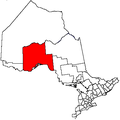External links
50°17′41″N89°26′59″W / 50.29472°N 89.44972°W / 50.29472; -89.44972
| Lake Superior Region | |
|---|---|
| Lake Huron Region |
|
| Southwest Region | |
| Southeast Region | |
| Cities | ||
|---|---|---|
| Towns | ||
| Townships | ||
| First Nations |
| |
| First Nations reserves |
| |
| First Nations settlements | ||
| Unorganized areas | ||
| Local services boards | ||
| Unincorporated communities |
| |
| | This Thunder Bay District geographical article is a stub. You can help Wikipedia by expanding it. |
